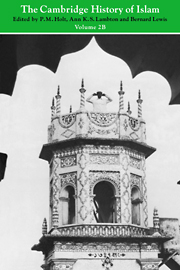Book contents
- Frontmatter
- Introduction
- PART VIII ISLAMIC SOCIETY AND CIVILIZATION
- 1 THE GEOGRAPHICAL SETTING
- 2 THE SOURCES OF ISLAMIC CIVILIZATION
- 3 ECONOMY, SOCIETY, INSTITUTIONS
- 4 LAW AND JUSTICE
- 5 RELIGION AND CULTURE
- 6 MYSTICISM
- 7 REVIVAL AND REFORM IN ISLAM
- 8 LITERATURE
- 9 ART AND ARCHITECTURE
- 10 SCIENCE
- 11 PHILOSOPHY
- 12 WARFARE
- 13 THE TRANSMISSION OF LEARNING AND LITERARY INFLUENCES TO WESTERN EUROPEo
- Dynastic List
- Bibliography
- Glossary
- Index
- References
12 - WARFARE
from PART VIII - ISLAMIC SOCIETY AND CIVILIZATION
Published online by Cambridge University Press: 28 March 2008
- Frontmatter
- Introduction
- PART VIII ISLAMIC SOCIETY AND CIVILIZATION
- 1 THE GEOGRAPHICAL SETTING
- 2 THE SOURCES OF ISLAMIC CIVILIZATION
- 3 ECONOMY, SOCIETY, INSTITUTIONS
- 4 LAW AND JUSTICE
- 5 RELIGION AND CULTURE
- 6 MYSTICISM
- 7 REVIVAL AND REFORM IN ISLAM
- 8 LITERATURE
- 9 ART AND ARCHITECTURE
- 10 SCIENCE
- 11 PHILOSOPHY
- 12 WARFARE
- 13 THE TRANSMISSION OF LEARNING AND LITERARY INFLUENCES TO WESTERN EUROPEo
- Dynastic List
- Bibliography
- Glossary
- Index
- References
Summary
The Arabs, within the two decades which followed the death of the Prophet Muhammad (11/632), won for themselves a large empire embracing Syria, Egypt,‘Irāq, Persia and much of Arabia itself. The battles at Ajnadayn (13/634), on the river Yarmuk (15/636) and at ‘Ayn Shams, i.e. Heliopolis (19/640), foreshadowed for the Byzantines the definitive loss of Syria and Egypt; the battles of al-Qādisiyya and Jalūlā’ (16/637) and at Nihāvand (20/641; marked crucial moments in the reduction of Sasanid ‘Irāq and Sasanid Persia to Muslim control. It was a conquest at once rapid, astonishing and durable.
The success of the Arabs must be ascribed in no small measure to the circumstances prevailing at that time in the conquered territories. Byzantium and Persia, a little before the Arab assault, had come to the end of a protracted conflict, extending over almost a hundred years and destructive of their resources—neither of these states was in a condition to meet a new and formidable threat from outside. Grievances political, religious and financial made the rule of Byzantium unwelcome to the populations of Syria and Egypt—populations which, being Semitic in origin, were more akin to the Arabs than to their masters at Constantinople. In ‘Irāq, too, there was a population of Semitic descent, also with grievances of a similar nature and little inclined to favour the alien domination of Persia. Throughout the lands constituting the Fertile Crescent the Arabs fought, therefore, with the mass of the local people passive towards their intrusion or, more often, sympathetic towards the Muslim cause.
- Type
- Chapter
- Information
- The Cambridge History of Islam , pp. 824 - 850Publisher: Cambridge University PressPrint publication year: 1977



